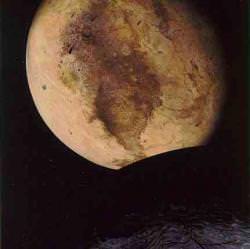The carnival is back in town. Once again, I'm happy to host all manner of space blogs with the Carnival of Space. This gives you a chance to see how there's a great big Universe of space writing out there. It's a big group this week.
adsensestart
On the 38th anniversary of the first Moon landing, FlyingSinger recalled where he was on that day, how a supportive teacher had helped him get there, and how being there helped him to get into college and beyond. It's really the story of how a young space nerd eventually became...
a much older space nerd
.
Astroblog has some stupid mobile phone tricks. Following "Animations of Venus", made with low cost equipment, the ultimate low cost astrophotography,
with a mobile phone camera
. Amaze your friends!
After a terrible week for NASA, voices are again being raised accusing the space program of being too expensive and too dangerous, an extravagant luxury we can't afford. This post on Cumbrian Sky looks at the recent events that have dominated the headlines, and concludes that despite setbacks like this, the "conquest of space" is ultimately inevitable, and something we should celebrate and support, not dismiss.
Phil for Humanity jumps into the debate whether people or robots should explore outer space.
He gives a more detailed investigation into both sides of the argument
.
Poor Pluto. As we near the one year anniversary of the IAU's historic 're-definition-ing' of the word planet, many people know that Pluto is no longer a planet, but a large majority of people don't know why Pluto is not a planet. The common misconception is that Pluto itself was demoted, when in fact, the definition of the word 'Planet' was changed; and Pluto just did not fit the definition. Astroversity gives you an easy-to-follow explanation of
why Pluto is no longer a planet
.
The Moon is an ideal location for a variety of observations. A Babe in the Universe has an article about how a 2-meter multi-wavelength instrument
could be placed on the Moon
in a short time at a surprisingly low cost.
Advancednano discusses a variant of the
nuclear thermal gaseous core rocket
, which does not put any radiation into the atmosphere yet has 6.7 times the ISP of the space shuttle and can lift 40 times the cargo of the space shuttle.
Want to hunt comets and asteroids using images from the STEREO spacecraft? Astroblog
gives you a handy guide
to help you along, and an important note on the pesky problem of parallax.
Astropixie talks
about the Martian blueberries
, how they were formed, and their implications for water and life on Mars.
When astronauts get back to the Moon, it would be handy if they could pick up their oxygen locally. Spacefiles explains the ways you can
extract oxygen from lunar regolith
.
Emily Lakdawalla from the Planetary Society blog has an article
about Saturn's moon Helene
. Voyager 2's best view of Helene showed a blob a few pictures across. Cassini has been getting closer and closer to Dione's co-orbital moon, and the most recent pictures showed a blocky world with sharp craters and mountainous ridges.
Selenian Boondocks has
a brief overview of some recent research
that suggests the our nearest neighbor might be a much more interesting place - both scientifically and economically - than previously imagined.
Centauri Dreams has an article called
Galactic Drift and Mass Extinction
. It looks at recent work on a possible cycle in mass extinction events on Earth that may be related to the Solar System's position in the Milky Way.
Normally cynical, the Space Cynics are downright excited by
the new 25 meter sub-millimeter telescope being built in Chile
.
Before people can dream about mining asteroids, we are going to need to figure out how to land on them first - a problem that NASA and DigitalSpace may have already solved. Colony Worlds
has the story
.
Robot Guy has the space video of the week. This time, it's the
X-Prize winning flight of Scaled Composites' SpaceShipOne
.
Dr. Pamela Gay has all the details on a new study of 231 low metallicity stars in the local neighborhood points to
past objects getting eaten by the Milky Way
. As these stars pass though out area as the orbit in from the Halo, they let us learn about their past: where they came from and when they where eaten.
Phil Plait highlights
some beautiful photographs of the Veil Nebula
, captured by the Hubble Space Telescope.
And finally, for my own humble submission, I look forward through time, though the
End of Everything
.
 Universe Today
Universe Today
